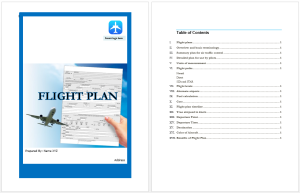When an airplane takes off for its destination, the pilots have all the knowledge required to take it off in the air and land it safely on the ground but there are many things that they need to be provided to land it safely on the ground. Elements i.e. time to take off, the air path for the plane, required altitude for the plane, fuel capacity and consumption of the plane, number of passengers on board, required speed of the plane to keep, route of the plane, and the destined airport to land the airplane. All these details and information are provided by the airport crew in the control tower and the document that includes all this information is called a flight plan.
Along with the pilots and the control tower at both airports, the flight plan is also provided to all the airports in between the route of the plane so that if there is a problem or change in the plan, the airports know what kind of plane they are going to deal with and how to handle the situation. Most of the time pilots act upon the flight plan and don’t move a finger out of the plan but there are some situations in which the pilots have to make instant decisions and make changes in the flight plan i.e. a possible fault in the airplane, malfunction in the electrical system of the plane, fuel leakage or an emergency on board with some passenger.
Importance of a Flight Plan:
Along with several other elements and perspectives, the flight plan is crucial for the airports so that the airplane can safely take off, move on the route, and again land safely on the ground. For example, if the control tower doesn’t know what kind of plane they are dealing with and what’s its size and measurements, how can they allow it to land at the airport along with dozens of other airplanes standing on the ground and taking off and landing at the same time. The flight plans are also very important in case a plane goes missing on the way over to the destination and the plan document, helps the search teams to search only through the route of the plane.
Here is a preview of a Free Printable Flight Plan Template created using MS Word,

Elements of a Flight Plan:
- Flight path or route
- Airway
- Navidad
- Direct
- SIDs and STARs
- Special use of airspace
- Flight altitude or height of the plane
- Destined airport
- Alternate airports
- Fuel capacity of the plane
- Fuel consumption of the plane
- Flight plan timeline
Types of flight plans:
- VFR
- DVFR
- IF
- Hybrid (combination of any of the above)
Some important terms used in flight plans:
- AGL (the height or altitude of an airplane above the ground level)
- ICAO (International Civil Aviation Organization)
- Knot (a specific unit of speed to measure the velocity of an airplane in the air)
- MSL (the average sea level height for the entire path of an airplane)
- Nautical mile (it is a unit of distance in aviation used for airplanes)
Here is the download link for above shown Flight Plan Template,
